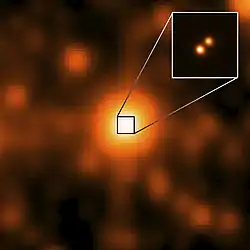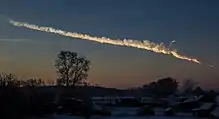(163364) 2002 OD20
(163364) 2002 OD20 is an asteroid, classified as a near-Earth object and potentially hazardous asteroid of the Apollo group, likely smaller than one kilometer in diameter.[1][3]
| Discovery[1] | |
|---|---|
| Discovered by | NEAT |
| Discovery site | Palomar Obs. |
| Discovery date | 21 July 2002 |
| Designations | |
| (163364) 2002 OD20 | |
| NEO · PHA · Apollo [1] | |
| Orbital characteristics[1] | |
| Epoch 13 January 2016 (JD 2457400.5) | |
| Uncertainty parameter 0 | |
| Observation arc | 5068 days (13.88 yr) |
| Aphelion | 1.8697 AU (279.70 Gm) |
| Perihelion | 0.86152 AU (128.882 Gm) |
| 1.3656 AU (204.29 Gm) | |
| Eccentricity | 0.36914 (e) |
| 1.60 yr (582.90 d) | |
| 267.34° | |
| 0° 37m 3.36s / day | |
| Inclination | 4.1884° |
| 259.99° | |
| 275.24° | |
| Earth MOID | 0.0261628 AU (3.91390 Gm) |
| Physical characteristics | |
Mean diameter | 0.46–1.0 km[2] |
| 2.420 h (0.1008 d) | |
| 18.8[1] | |
It was scheduled to be observed by Goldstone radar in May 2013.[4] It has a well determined orbit and made a close approach to Earth on 23 May 2013, at a distance of 0.0387 AU (5,790,000 km; 3,600,000 mi).[1][4] It is due to make another close pass on 23 May 2131, coming as close as 0.0248 AU.[1] It was discovered on 21 July 2002 by astronomers of the Near-Earth Asteroid Tracking survey at Palomar Observatory in California.[5] With an absolute magnitude of 18.8,[1] the diameter is estimated to between 460 and 1030 meters.[2]
References
- "JPL Close-Approach Data: 163364 (2002 OD20)" (2009-09-28 last obs and observation arc=7.8 years). Retrieved 7 April 2016.
- "Absolute Magnitude (H)". NASA/JPL. Retrieved 13 August 2012.
- "Target Asteroids! List of Near-Earth Asteroids" (PDF).
- "Goldstone Asteroid Schedule". Retrieved 13 August 2012.
- "List Of The Potentially Hazardous Asteroids (PHAs)". Minor Planet Center. Retrieved 13 August 2012.
External links
- (163364) 2002 OD20 at AstDyS-2, Asteroids—Dynamic Site
- (163364) 2002 OD20 at ESA–space situational awareness
- (163364) 2002 OD20 at the JPL Small-Body Database
This article is issued from Wikipedia. The text is licensed under Creative Commons - Attribution - Sharealike. Additional terms may apply for the media files.



